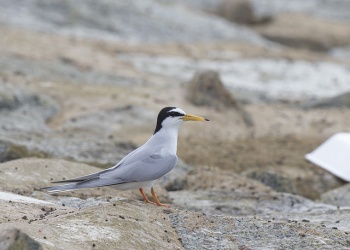- Sternula albifrons
Sterna albifrons
Identification
Length 21–25 cm, Wingspan 41–47 cm, weight 47–63 g
- Wings grey with outer two primaries blackish in breeding season; body mostly white except for grey mantle between the wings; rump and tail white (pale grey in some subspecies).
- Adult summer has yellow bill with black tip, black crown, nape and lores, well defined white forehead (extending to just behind the eye), and orange legs and feet.
- Adult winter has dark bill, legs and feet, white lores and forecrown, blackish hindcrown with whitish streaks and black nape.
- Juvenile has brownish-black chevrons on mantle and wing covert feathers, yellowish-based grey-brown bill, and yellowish legs.
- First-winter resembles non-breeding adult but has dark subterminal markings on mantle, scapulars, tertials and wing-coverts.
Similar species
Least Tern has a greyer rump and central tail feathers, but is otherwise barely distinguishable on plumage; it does though has a distinctive 'squeaky' call (a vagrant Least Tern in a Little Tern colony in Britain was by far most easily picked out by this character, and was nicknamed 'Squeaker'[1]). Saunders's Tern in breeding plumage differs in less white on the forehead (not reaching behind the eye), grey rump, and three darker outer primaries; its legs are also darker reddish-orange.
Distribution
Breeds in Europe, northern Africa, Asia, and eastern Australia. Most populations strongly migratory (S. a. guineae and S. a. placens largely resident), wintering south to South Africa, southern Australia and New Zealand.
Taxonomy
Little Tern is closely related to, and was formerly often considered conspecific with, Saunders's Tern S. saundersii of the northern Indian Ocean and Least Tern S. antillarum of the New World. Other close relatives include the Yellow-billed Tern S. superciliaris and Peruvian Tern S. lorata, both from South America. Like all these, it was formerly placed in the genus Sterna.
Subspecies
There are five recognized subspecies[2]:
- S. a. albifrons:
- S. a. guineae:
- S. a. innominata:
- Islands in Persian Gulf
- S. a. sinensis:
- Resident northern India and Sri Lanka east to southeastern Asia, the Philippines, and northern Australia; also breeds southeastern Siberia and Japan south to southeastern China, wintering to New Guinea and Australia
- S. a. placens:
Habitat
Sand, gravel or shingle coasts and islands; also inland on larger rivers and lakes. Breeds in small colonies, typically around 10–100 pairs. The nesting area will most often be located close to both the sea and to fresh water, but in some areas also found near freshwater such as rivers.
Behaviour
Breeding
One to three eggs are laid on the ground. The nest is a scrape in the ground, usually on a shingle beach. The pair take turns incubating the eggs which hatch after 18 to 21 days. Chicks start to fly after 8 to 14 days but are not fully fledged until they are 28 days old.
Little Terns are fiercely protective of the eggs and chicks and will follow and harass any perceived predator.
Diet
It plunge-dives for fish.
Vocalisation
References
- Yates, B. (2010). Least Tern in East Sussex: new to Britain and the Western Palearctic. Brit. Birds 103: 339-347 (abstract).
- Clements, J. F., T. S. Schulenberg, M. J. Iliff, S. M. Billerman, T. A. Fredericks, J. A. Gerbracht, D. Lepage, B. L. Sullivan, and C. L. Wood. 2021. The eBird/Clements checklist of Birds of the World: v2021. Downloaded from https://www.birds.cornell.edu/clementschecklist/download/
- Birdforum thread discussing id of Saunders' vs Little Tern
Recommended Citation
- BirdForum Opus contributors. (2024) Little Tern. In: BirdForum, the forum for wild birds and birding. Retrieved 26 April 2024 from https://www.birdforum.net/opus/Little_Tern
External Links
GSearch checked for 2020 platform.








